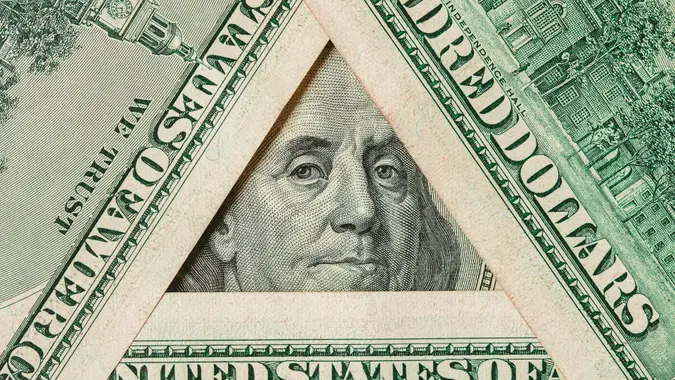Trump’s $2K Dividend: What Middle-Income Americans Could Expect

Commitment to Our Readers
GOBankingRates' editorial team is committed to bringing you unbiased reviews and information. We use data-driven methodologies to evaluate financial products and services - our reviews and ratings are not influenced by advertisers. You can read more about our editorial guidelines and our products and services review methodology.

20 Years
Helping You Live Richer

Reviewed
by Experts

Trusted by
Millions of Readers
You may have heard about President Donald Trump’s idea of a possible $2,000 tariff “dividend” check. If you’re like many struggling Americans, you may wonder what a proposed $2,000 dividend from the Trump administration could mean for your finances.
While the idea may sound good, there are still many uncertainties surrounding it.
Short on Specifics
In mid-November, White House press secretary Karoline Leavitt said President Trump is “committed” to those $2,000 dividend checks. While she didn’t provide details, Leavitt noted officials are looking to explore ways to create a plan using tariff revenue.
According to Newsweek, citing a White House official, the Trump administration is looking at the dividends as one way to put the tariff money “to good use for the American people.” Again, however, there were no specifics mentioned. The remarks from the White House came days after Treasury Secretary Scott Bessent told ABC News the tariff dividend could come in lots of forms and perhaps refer to tax savings enshrined by the One Big Beautiful Bill legislation.
Not Everyone Could Qualify
You may also be wondering whether every American would receive a check. Based on Trump’s social media posts, it would appear only low- and middle-income U.S. citizens would qualify. However, he didn’t specify a cutoff point or whether the income level would be based on regional or national standards.
Treasury Secretary Bessent, however, has suggested a possible income cutoff of $100,000, USA Today reported. If that figure were to be used, what could it mean for middle-income Americans? As reported by U.S. News, Pew Research Center’s 2025 estimate of middle-class income ranges from $41,392 to $124,176. The higher end of that range surpasses the possible cutoff proposed by Bessent, but nothing is certain as of now.
There are at least two big financial aspects middle-income households should also keep in mind with the dividend idea. First, as noted by Business Insider, it’s possible you wouldn’t come out ahead with $2,000 more. Because some companies have passed tariff costs to shoppers, you’re likely already paying for some of the tariff revenue, it reported. Additionally, there are serious doubts being raised about whether the government can afford to issue these dividends. According to CNN, experts say it’s improbable that these checks will be sent out next year.
Ideas for the Money
Let’s say the government ends up sending these $2,000 checks — what should middle-income Americans do with it?
According to many experts, two good options would be to put it toward paying off your debts and padding your emergency fund. If you’re good in those areas, you could then look at savings and investing options.
Editor’s note on political coverage: GOBankingRates is nonpartisan and strives to cover all aspects of the economy objectively and present balanced reports on politically focused finance stories. You can find more coverage of this topic on GOBankingRates.com.
More From GOBankingRates
 Written by
Written by  Edited by
Edited by 

























